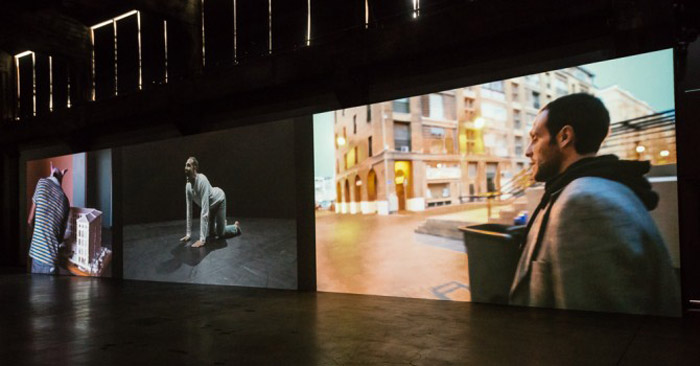Featuring an abandoned apartment building, a mysteriously vacant concert hall, and a trash-filled pavilion, André Fortino’s video triptych, Hôtel Formes Sauvages is a journey into the manic, startling, and often disturbing world of performance art. The exhibition—held at the Fonderie Darling’s Gallery in Cité Multimedia—is Fortino’s first show in North America. The main hall is an industrial-style warehouse, featuring exposed piping high above the audience’s head and a vast brick wall on the far end of the room. On the largest wall were three massive projection screens showing the videos.
The video triptych consisted of three side-by-side screens. The left-most screen showed footage of an improvised performance, Hôtel Dieu (2009), in which Fortino, dressed in a rubber pig mask, explores a series of abandoned sites and interacts with the objects found in each space. In the first scene, he drags a bag of yarn into an abandoned room in an apartment building and proceeds to entangle himself in the yarn. On the right-most screen there was Les Paradis Sauvages (2012). While different, the two videos obviously echo each other in theme and visual qualities. While Fortino covers himself in yarn, in the other video, he stands in a field and frantically tapes wooden mannequin limbs to his extremities. Simultaneously, the artist in both videos attempts to leave, only to find that these objects obstruct his path.
This is just one example of the recurring similarities that permeate both videos. In each, the artist encounters objects and interacts with and manipulates them in ways that are often startling or disturbing. In another scene, the artist in a pig mask drags mannequin heads around a room, arranging them in a sort of violent, organized chaos. Meanwhile, on the other video screen, the artist roughly drags the limp figures of fellow artists and places them seemingly randomly in an empty warehouse.
The third component of the triptych was shown on the centre screen. The video was a recording of a dance piece, “Le Corps des Formes Live,” developed with choreographer Katharina Christl. While the other two videos are complex, and at some points manic in both their audio and video, the dance piece is relatively calm. The inclusion of this video eases the somewhat disturbing nature of parts of the other films by grounding the audience in a more familiar realm of performance art.
The choreography piece is a filmed version of a live performance by Fortino. While the live and recorded versions were almost entirely the same in content, Fortino’s presence for the performance put the entire exhibition in the context of the artist’s energy, which made it much easier to appreciate the other videos. In the live performance, Fortino contrasted stiffness and explosive movement by leaping up and down excitedly, running at full speed then coming to a sudden stop, and staying still for minutes on end, often twisted into unnatural shapes. Fortino used the entire gallery space for his performance, including intimate interactions with the walls and floor (at one point he spent several moments licking one gallery wall). Meanwhile, the only soundtrack was his heavy breathing, although it was uncertain if this was exaggerated due to the movement, or a natural product of the performance.
The exhibition was unclear as to whether the artist was actually utilizing cinematography as a medium or simply as a recording of his performances. Just as videos of Marina Abramovic and Joseph Beuys’ famed performances are less than the real thing, it seems unusual and less effective for a Fortino to exhibit videos of an improvised performance. Viewing the video triptych as an object of art itself resolves this issue, although the inclusion of the performance made this point confusing.
Fortino’s endeavours into video for Hôtel Formes Sauvages were not always effective. Had the live performance not occurred prior to the videos, the energy and commitment that was obvious in the performance may have gone by unnoticed. Not only did the exhibition feel inconclusive, but it was difficult to decipher what questions, if any, were raised. The interaction of the artist with various found objects was far too disparate to be seen as one metaphor, and other than the aesthetic style, there wasn’t much connection between the videos and the Fortino’s performance. The exhibition was exciting in its visual qualities, but lacking in relatable substance.







